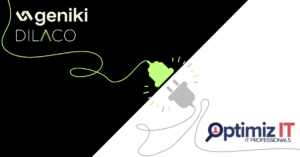As technology evolves, so do companies and their workflows. More and more businesses are open to the possibility of remote work. Since the pandemic, job positions involving telework have increased from 2.5% to almost 7.5%, and it looks like remote work is here to stay.
Be it full-time or half-time, remote work has been making employees’ lives easier, promoting a greater work-life balance. Remote work is also in the best interest of organizations, benefiting productivity and allowing companies to attract and retain talent that might be a better match, no matter their location. But what IT challenges does it bring to you and your company?
The cybersecurity challenge
Cybersecurity for remote workers requires a very specific security approach. You need to make sure that the connection is safe at all times and everywhere. But, because of the specificity of this work model, cybersecurity can be tricky.
Authentication made difficult
Normally, authenticators will be triggered by any suspicious activity. For example, when employees usually log in from Belgium during expected work hours, nothing gets triggered. When they do something that seems like the complete opposite, for example they log in in the middle of the night from China, this will be flagged by the authenticator as suspicious behaviour. However, in an always-on work model it is very difficult to find patterns in the activity of the end-user, because the employee could be working from anywhere and at any time. This will make it harder to protect the end-user and your company.
The use of own devices
An always-on work culture also means the use of personal devices such as smartphones for work related tasks. For the end user, using this smartphone often ensures a more convenient and pleasant way of working. But for the company, this represents an extra risk.
By using their personal devices, the number of endpoints will increase and, consequently, the attack surface that could be used to compromise your data. Moreover, personal devices are usually less protected and more vulnerable than work devices, heightening the risks of cyber threats.
Unsecured networks
And finally, in order to be able to work anywhere and anytime, the use of other networks is necessary. While working at the office, the used network is highly protected. The same cannot be said about home Wi-Fi or, even worse, public Wi-Fi.
Public Wi-Fi is especially dangerous because it is often completely unsecured, allowing cybercriminals to sneak in and steal data or even inject malicious software. And the worst part is that the end-user is unaware of this, or just doesn’t know what the alternatives are.
The challenges of remote support
Let’s say you have the best cybersecurity practices in place, but now the end-user has a problem with the authentication and cannot log in, or maybe he can’t connect to the network. Small issues can wait, but sometimes the problem needs to be solved urgently and giving remote support is sometimes easier said than done. In these cases, the employee will be powerless and will not be able to continue working.
So especially when being part of an always-on work culture, a 24×7 service desk is a necessity. But creating your own service desk that can manage every issue at any time, can turn out to be quite expensive.
The tug of war between productivity and cybersecurity
As we’ve seen, while hybrid and remote work models are in demand, they open the door to various user issues and cybersecurity risks.
When allowing employees to work remotely, you need to ensure the devices are working smoothly at any time and that a safe connection and adequate support will be present. But your colleagues want to do their work easily and without complications, and if there are any, they might try to bypass any complex procedures. Or they might go and find their own solutions for their issues, which offers maybe an immediate gratification but can cause damage afterwards.
So, on the one hand, you need to maximize your company’s protection, making it as difficult as possible for cyber threats to prevail. On the other hand, the complexity of your cybersecurity strategy should not obstruct the end users’ performance and experience.
So what now?
Not sure where to start? Here are some tips you can implement in order to improve your network security for remote access, while taking the user-experience into account:
- Using a password manager
It is hard to keep track of all passwords, but this solution can help end users with the safe storage of their passwords, by storing them in an encrypted form. - Using a multi-factor authentication (MFA)
This will provide an extra layer of security, reducing the risk of compromising the identities of the end users. - Integrating your MFA with a SSO (single sign on) solution
The creation of multiple complex passwords for each application and platform will no longer be needed, as this solution only requires one set of login credentials. This will save time and make the experience more end-user friendly while keeping their identities safe. - Implementing a cybersecurity awareness program
If employees are informed about the best cybersecurity practices, as well as the consequences of not following them, it will most likely increase their compliance, reducing the vulnerability. - Implementing data-centric security
This will add an extra layer of security on the data itself, no matter which device (work or personal) is used to access the data.
You can use the tips above to create your strategy, but you don’t have to do it all on your own. At Dilaco we offer a comprehensive network security service. We will identify risks and challenges and create a tailored defence strategy, so you can offer the best protection possible to your end users and your company while keeping your network available at all times.
Additionally, our IT support services have a shared service desk available 24/7/365 for you. We deliver fast problem-solving, boosting your cost-efficiency and allowing you and your end users to focus on what really matters.
Still not convinced? Let us know what your concerns are.
Sources:
Will Remote Work Persist after the Pandemic?
10 Benefits of Remote Work for Businesses
Productivity Vs Security: The Balancing Act That Companies Must Achieve At All Costs!
Cybersecurity for Remote Workers: How Organizations Are Addressing The Risks





